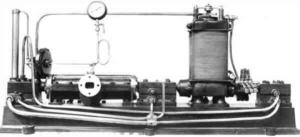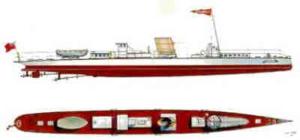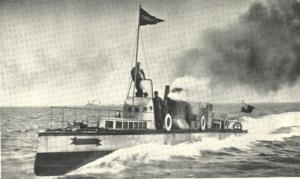 SKC Films Library SKC Films Library |
| SKC Films Library >> Technology >> Engineering (General) |
| Sir Charles Parsons steam engine builder and inventor of the steam turbine
Charles Algernon Parsons was born in London on June 13, 1854. He was the fourth son of the 3rd Earl of Rosse, a distinguished engineer and astronomer; his mother, Mary Countess of Rosse, was a photographer who was also adept at architectural design and cast-iron foundry work. He spent most of his childhood at the family's estate of Birr Castle in County Offaly, Ireland, where his father had built the world's largest telescope (6-foot diameter). Privately tutored by some of the most preeminent men of his day, young Charles proved to be an exceptionally bright and inquisitive student. In 1866, he and his brothers constructed a 4-horsepower steam carriage which reputedly traveled at 10 mph. He studied at Trinity College, Dublin, from 1871 to 1873, before moving on to St. John's College, Cambridge, from which he obtained his bachelor's degree in mathematics in 1877. In 1877, Parsons became an apprentice at the W.G. Armstrong & Co. works at Elswick, where he was allowed to develop and build his own steam engine, as long as he paid for his own materials and labor costs. Called an epicycloidal (reciprocating) engine, it had cylinders that rotated around the crankshaft, but at half its speed. Armstrong had little interest in Parsons' engine, however, so in 1881 he joined the experimental staff at Kitson's of Leeds. Here, he turned his attention to rocket-powered torpedoes. Although his experiments in this field were unsuccessful, they provided a useful background for his future work on the steam turbine. In 1884, Parsons entered into a partnership with Clarke, Chapman and Company of Gateshead. The firm wanted a high-speed steam engine to drive a dynamo, so Parsons decided to forget the reciprocating engine and turned to the idea of a steam turbine. The first turbine was built in 1884; within five years more than 350 had been supplied, including the first for a public power station. Parsons' multi-stage reaction
turbine The partnership was dissolved in 1889, and Parsons established his own works at Heaton, Newcastle-upon-Tyne, where he manufactured steam turbines, dynamos and other electrical apparatus. Parsons also used the resources of his company to help him design a marine version of his steam turbine engine. In 1894, he took out a patent for "propelling a vessel by means of a steam turbine, which turbine actuates the propeller or paddle shaft directly or through gearing." That same year, he established the Marine Steam Turbine Company at Wallsend-on-Tyne to build a prototype. The result of Parsons' work was the Turbinia, a turbine-driven vessel that was 100 feet long and 9 feet broad, with a draught of 3 feet and displacement of 44½ tons. It was fitted with a double-ended water tube boiler working at 210 psi. The first set of machinery consisted of a single radial flow turbine driving a single shaft, which at 2,400 rpm developed 960 hp. Parsons had expected the vessel to achieve a speed of 34½ knots, but during preliminary tests the highest speed recorded was less than 20 knots. It turned out that the problem was due to the high rotational speeds of the propellors (18,000 rpm), which actually caused the water pressure to decrease, forming bubbles, meaning that most of the power was going into making bubbles instead of pushing the boat. Parsons remedied the "bubbling" problem by replacing the radial flow turbine with three parallel flow turbines -- one high, one intermediate and one low pressure -- to reuse the same steam in succession. Each turbine drove a separate shaft attached to three triple-bladed screws (9 propellers in all). With the steam at 157 psi, the central shaft turned at 2,000 rpm and the wing shafts at 2,230. This new configuration allowed the Turbinia to reach a speed of 34½ knots. Although the Turbinia was capable of speeds much faster than any ship currently in operation, he had trouble getting potential investors, so to show the world just what his little vessel was capable of he decided to "crash" the 1897 Naval Review. On June 26, some 165 of the finest ships in the Queen's Navy were assembled at Spithead, in the south of England, to honor the 60th anniversary of Queen Victoria's accession. Just as the review was about to begin, the Turbinia dashed out and sped past the line of ships. A pursuit boat was sent out to intercept the Turbinia, but Parson's little ship not only outran the pursuer but almost swamped it with its wake. The crowd, which included Prince Henry of Prussia, brother of the Kaiser, was astonished. Parsons had decisively proven the abilities of his turbine steam engine. On November 21, 1899, the HMS Viper became the world's first turbine driven destroyer, and by 1904, 26 ships had been fitted with direct drive turbine engines designed and built by Parsons -- including the Mauretania, the Titanic, and the HMS Dreadnought. Parsons' engine also became the standard for electric power generation on land. Turbinia speeds past the naval
review In addition to his work with steam turbines, Parsons also experimented with gearing, optical instruments, and attempts to crystallize carbon. His numerous inventions include the Auxetophone, a mechanical amplifier for stringed musical instruments. Parsons also occupied important positions on the directorate of various electrical supply and engineering companies. He was made F.R.S. in 1898, awarded the Royal Society's Rumford Medal in 1902, and knighted in 1911. In 1926, he collected and published his father's papers, The Scientific Papers of William Parsons, Third Earl of Rosse (1800-1867). Sir Charles Algernon Parsons died on February 11, 1931, while on a cruise in the West Indies. PRINT SOURCE INTERNET SOURCE SEE ALSO |
| SKC Films Library >> Technology >> Engineering (General) This page was last updated on June 13, 2017. |



